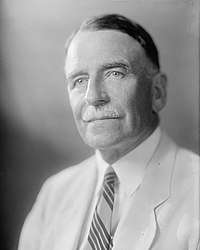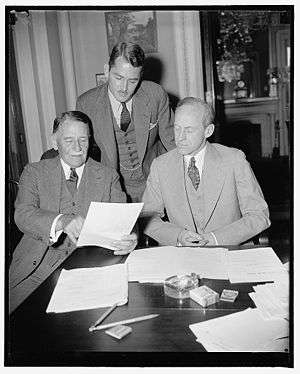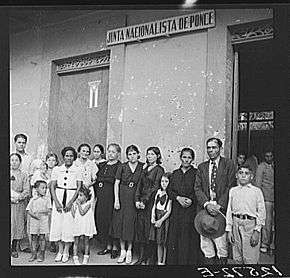Blanton Winship
| Blanton Winship | |
|---|---|
 | |
| Governor of Puerto Rico | |
|
In office February 5, 1934 – June 25, 1939 | |
| President | Franklin D. Roosevelt |
| Preceded by | Benjamin Jason Horton |
| Succeeded by |
José E. Colón (acting) William D. Leahy |
| Personal details | |
| Born |
November 23, 1869 Macon, Georgia, U.S. |
| Died |
October 9, 1947 (aged 77) Washington, D.C., U.S. |
| Resting place | Rose Hill Cemetery |
| Profession | Military |
| Military service | |
| Allegiance |
|
| Service/branch |
|
| Years of service |
1898–1933 1942–1944 |
| Rank |
|
| Commands |
Judge Advocate General |
| Battles/wars |
Spanish–American War Pancho Villa Expedition World War I World War II |
| Awards |
Distinguished Service Cross Distinguished Service Medal Silver Star (2) |
Blanton C. Winship (November 23, 1869 – October 9, 1947) was an American military lawyer and veteran of both the Spanish–American War and World War I. During his career, he served both as Judge Advocate General of the United States Army and as the governor of Puerto Rico.
Early life and education
Blanton Winship was born in Macon, Georgia, and graduated from Mercer University in 1889. He received a law degree from the University of Georgia in 1893, where he also played football for one year.[1]
Career
Military service
During the Spanish–American War, Winship joined the 1st Georgia Infantry, a volunteer force. After the war, he elected to join the United States Army as a judge advocate. He remained in the military through 1914, when he began to teach law at the Army Service School at Fort Leavenworth, Kansas.
When World War I broke out, he fought in France and led several campaigns. Winship commanded the 110th and 118th Infantry Regiments in the 28th Division while also serving as the Staff Judge Advocate of First Army. Winship was awarded the Distinguished Service Cross for "extraordinary heroism in action near Lachaussee, France, November 9, 1918." He also received the Silver Star for gallantry in action near Villers sur Fere, France.[2]
Following the war, Winship returned to military law. He was appointed to serve as a military aide to President Calvin Coolidge. Eventually he became the Judge Advocate General of the Army, a position he held from 1931 to his retirement from service in 1933.
World War II

During World War II, Winship returned to active duty. During this time, he set precedents for military tribunals in the United States during participation in the military commission (created in July 1942) to try Nazi saboteurs arrested in this country. Winship retired for good in 1944. At 75, he was at that time the oldest Army officer on active duty.
Governor of Puerto Rico

In 1934, Winship was appointed by Franklin D. Roosevelt as governor of Puerto Rico, succeeding Robert Hayes Gore. This was in part due to major strikes that had taken place that year, causing the administration to fear social unrest. Colonel Francis Riggs accompanied Winship as chief of police. Riggs formerly had assisted Nicaragua's dictator Anastasio Somoza.
As governor, Winship's primary mission was to crush the Puerto Rican Nationalist Party, by imprisoning its leadership and intimidating the rank-and-file membership.[3] Upon arrival he immediately set out to "militarize" the Insular Police force, arming it with machine guns and riot control equipment. Winship also recruited a new police chief, E. Francis Riggs, whose background was in military intelligence, and whose immediate prior occupation had been to "advise" Anastasio Somoza in Nicaragua. Together, Winship and Riggs spent their weekends inspecting the new vigorous police training camps (modeled after military boot camps) which they created throughout the island.[4]
During his time in office, Winship fought to exclude the recently passed minimum wage laws from applying to Puerto Rico, as it would have doubled the hourly wage of 12.5 cents which was standard for sugarcane plantation workers. Although this decision was unpopular, when the new minimum-wage law was applied to Puerto Rico, nearly two-thirds of the island's textile factories closed because they could not afford the increase in wages and remain profitable.
Winship criticized many of Secretary of the Interior Harold L. Ickes's policies toward the island (Interior had responsibility for territories and insular affairs). Relief spending during the Great Depression for Puerto Rico was (per capita) far below either that of the mainland or Hawaii. This lack of spending contributed to the poverty of the island, and in turn to social unrest.
In October 1935, the Insular Police killed four Puerto Rican Nationalist Party members at the University of Puerto Rico in Rio Piedras, a neighboring town next to San Juan. The event became known as the Rio Piedras Massacre.[5] Ramón S. Pagan, Pedro Quiñones, Eduardo Rodríguez Vera, José Santiago Barea and a bystander were killed. On February 23, 1936, the nationalists Hiram Rosado and Elias Beauchamp retaliated by killing Col. Riggs in San Juan. Captured, both Rosado and Beauchamp were executed at the police headquarters without trial. No law enforcement officer ever stood trial for the executions.
Following these events, the government rounded up numerous Nationalist Party members and charged them with sedition. The party's president, Pedro Albizu Campos, and others were sentenced to 10 years in prison by a United States federal court.
The Ponce massacre

On Palm Sunday (March 21), 1937, Governor Winship cancelled a Nationalist parade, which was to have taken place in Ponce to commemorate the 1873 abolition of slavery, only an hour before it was to have begun. When the march continued anyway, Winship ordered police to fire upon the marchers and bystanders. They killed 19 people and wounded more than 200, all of whom were unarmed. 150 protesters were arrested. This event, called the Ponce massacre, sparked outrage across the island and in the U.S. Congress.
The Minnesota Representative John Bernard gave a speech on April 14 denouncing the action. The full speech can be seen in the Congressional Record of April 14, 1937, page 4499. ongressman Vito Marcantonio of New York also criticized Winship, and in 1939, President Roosevelt eventually replaced him as governor of Puerto Rico.[6]
Following these events, many of the leaders of the Nationalist party were tried for insurrection, and after a hung jury and retrial, six were sentenced to life in prison.[5] Because the prosecutors were appointed by Governor Winship, Congressmen Vito Marcantonio and John T. Bernard suggested that this may have contributed to a bias in Winship's favor.[6]
A second panel, an independent investigation led by Arthur Garfield Hays, general counsel of the American Civil Liberties Union, with Fulgencio Pinero, Emilio Belaval, Jose Davila Rice, Antonio Ayuyo Valdivieso, Manuel Diaz Garcia, and Franscisco M. Zeno, as members, concluded that the police acted as a mob, and that the events on March 21 constituted a massacre. Their report harshly criticized the repressive tactics and massive civil rights violations by the administration of Governor Winship.[7]
Removal from office
Following the events of the Ponce massacre, a grand jury convened to investigate the Ponce events, but it was closed before it could indict anyone. The prosecutor investigating the case reported at a news conference that Governor Winship was interfering with his investigation and resigned under protest.[8] Almost simultaneously with the prosecutor's investigation, a federal law which allowed public officials to be indicted was repealed, effectively granting Governor Winship immunity from further prosecution.
The following year, Governor Winship moved the celebration of the 40th anniversary of the United States invasion of Puerto Rico from the traditional San Juan location to the city Ponce. During this celebration, on July 25, 1938, Ángel Esteban Antongiorgi attempted to assassinate the governor and managed to fire several shots before being killed by the police (one police officer was also killed in the attempted assassination).
Congressional turmoil continued to cloud the Winship governorship and President Roosevelt removed Winship from office on May 12, 1939 after charges were filed against him by New York Congressman Vito Marcantonio. President Roosevelt appointed William D. Leahy as Winship's successor, although Leahy did not take office for several months (during which time José E. Colóm served as acting governor).
Legacy and death
Winship's term had united many of the political factions in Puerto Rico against him. The newly formed Popular Democratic Party (PPD) had strong wins in 1940, taking a majority of seats in the Senate of Puerto Rico, and continued to gain strength through the 1940s. By 1950, the PPD held all but one seat in the senate.
Winship died in the United States and was buried at the Rosehill Cemetery in Georgia.
See also
Notes
- ↑ Reed, Thomas Walter (1949). Chapter XVII: "Athletics at the University from the Beginning Through 1947", in History of the University of Georgia, Athens, Georgia: University of Georgia Press. imprint pp. 3432–3433
- ↑ "Regimental History", The Judge Advocate General's Corps
- ↑ A. W. Maldonado, Luis Muñoz Marín: Puerto Rico's Democratic Revolution, (San Juan, PR: Editorial Universidad de Puerto Rico, 2006) p. 121.
- ↑ A. W. Maldonado, Luis Muñoz Marín: Puerto Rico's Democratic Revolution, (San Juan, PR: Editorial Universidad de Puerto Rico, 2006) pp. 119–121.
- 1 2 Aida Belen Rivera Ruiz, Certifying Official, and Juan Llanes Santos, Historian, and Jacqueline Pagan, Architect. Puerto Rico Historic Preservation Office. (San Juan, Puerto Rico) October 11, 2005. In National Register of Historic Places Registration Form - Casa de la Masacre. United States Department of the Interior. National Park Service. (Washington, D.C.) Section 8, Page 5. Listing Reference Number 05001098. October 20, 2005.
- 1 2 Congressman Vito Marcantonio, Five Years of Tyranny Archived 2012-01-12 at the Wayback Machine., The World of Piri Thomas: Piri Thomas official website. Note: The entire speech is contained in the Congressional Record of August 14, 1939. Part of it reads:
In his 5 years as Governor of Puerto Rico, Mr. Blanton Winship destroyed the last vestige of civil rights in Puerto Rico. Patriots were framed in the very executive mansion and railroaded to prison. Men, women, and children were massacred in the streets of the island simply because they dared to express their opinion or attempted to meet in free assemblage."
Retrieved November 23, 2009. - ↑ American Gunfight: The Plot to Kill Harry Truman--And the Shoot-Out That Stopped It. Simon and Schuster. 2005. ISBN 0-7432-8195-0. Retrieved 2009-03-17.
- ↑ http://www.enciclopediapr.org/ing/article.cfm?ref=06102005&page=2
External links
- The Judge Advocate General's Corps: "Our History"
- FBI Files on Puerto Rico timeline, 1930s
- Top Army Lawyer Also Was A Combat Hero…Winship's Record In Puerto Rico Was Hardly Heroic by Robert F. Dorr, Puerto Rico Herald. May 3, 2004.
- Mike Dover (February 16, 2008). "Blanton C. Winship". Major General. Find a Grave. Retrieved October 30, 2011.
| Political offices | ||
|---|---|---|
| Preceded by Benjamin Jason Horton (acting) |
Governor of Puerto Rico 1934—1939 |
Succeeded by José E. Colón (acting) |